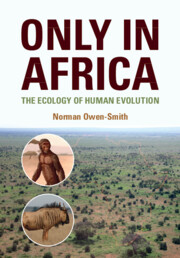Book contents
- Only in Africa
- Only in Africa
- Copyright page
- Dedication
- Contents
- Foreword
- Preface
- Abbreviations
- Part I The Physical Cradle: Land Forms, Geology, Climate, Hydrology and Soils
- Part II The Savanna Garden: Grassy Vegetation and Plant Dynamics
- Part III The Big Mammal Menagerie: Herbivores, Carnivores and Their Ecosystem Impacts
- Part IV Evolutionary Transitions: From Primate Ancestors to Modern Humans
- Appendix Scientific Names of Extant Animal and Plant Species Mentioned in the Book Chapters (Ecologically Conservative with Regard to Species Recognition)
- Index
- References
Part III - The Big Mammal Menagerie: Herbivores, Carnivores and Their Ecosystem Impacts
Published online by Cambridge University Press: 09 September 2021
- Only in Africa
- Only in Africa
- Copyright page
- Dedication
- Contents
- Foreword
- Preface
- Abbreviations
- Part I The Physical Cradle: Land Forms, Geology, Climate, Hydrology and Soils
- Part II The Savanna Garden: Grassy Vegetation and Plant Dynamics
- Part III The Big Mammal Menagerie: Herbivores, Carnivores and Their Ecosystem Impacts
- Part IV Evolutionary Transitions: From Primate Ancestors to Modern Humans
- Appendix Scientific Names of Extant Animal and Plant Species Mentioned in the Book Chapters (Ecologically Conservative with Regard to Species Recognition)
- Index
- References
Summary
Africa’s large herbivore assemblage is the product of the environments that also nurtured human origins and these animals contributed to evolutionary transitions in our hominin lineage. Around 90 species of large herbivore can be tallied on the continent, around half of them associated with the savanna biome (Figure III.1; the rest live in forests or deserts). All of them are ungulates, representing the orders Artiodactyla (with even-toes) and Perissodactyla (with odd-toes), except for the African elephant (Proboscidea). They span a range in body mass from ~5000-kg elephants down to 5-kg dikdiks.
- Type
- Chapter
- Information
- Only in AfricaThe Ecology of Human Evolution, pp. 141 - 246Publisher: Cambridge University PressPrint publication year: 2021

